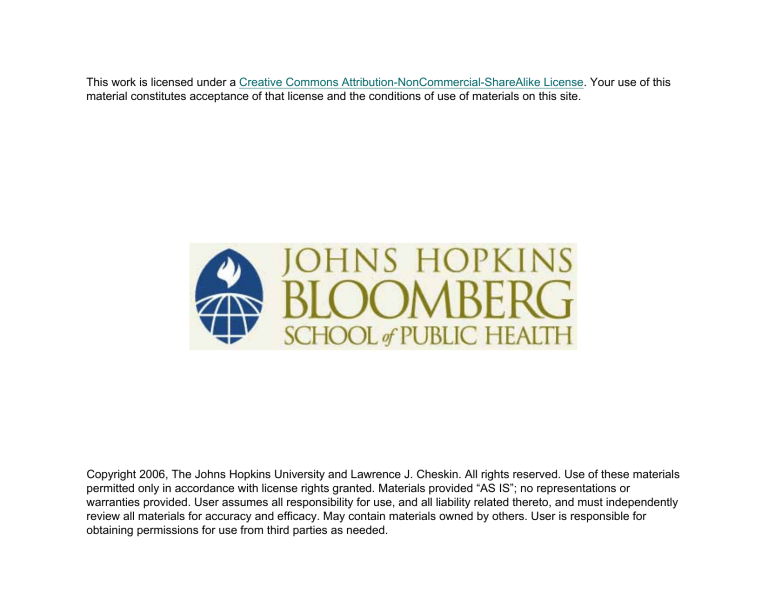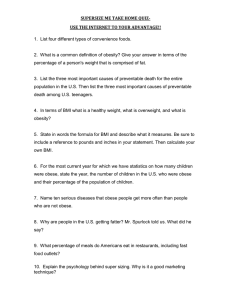licensed under a . Your use of this Creative Commons Attribution-NonCommercial-ShareAlike License

This work is licensed under a Creative Commons Attribution-NonCommercial-ShareAlike License . Your use of this material constitutes acceptance of that license and the conditions of use of materials on this site.
Copyright 2006, The Johns Hopkins University and Lawrence J. Cheskin. All rights reserved. Use of these materials permitted only in accordance with license rights granted. Materials provided “AS IS”; no representations or warranties provided. User assumes all responsibility for use, and all liability related thereto, and must independently review all materials for accuracy and efficacy. May contain materials owned by others. User is responsible for obtaining permissions for use from third parties as needed.
Critical Analysis of Popular
Diets and Supplements
Division of Human Nutrition
Instructor: Lawrence J. Cheskin, M.D.
Associate Professor, International Health
Director, Johns Hopkins Weight
Management Center
Course Schedule
{
{
{
{
{
{
4-5 introductory lectures
Instruction in use of analysis programs
Sample diet analysis
Midterm
Student presentations and discussion
Final
Lecture Topics
{
{
{
{
Dieting and Obesity in the US
Ingestive Science: The Control of
Eating
Digestion and Metabolism
Dietary Supplements
Medical Aspects of
Obesity and Dieting
Do You Know Your Own BMI?
BMI = weight(kg)/height(m)²
Weight (lbs)
120 130 140 150 160 170 180 190 200 210 220 230 240 250
Height
6’ 16 18 19 20 22 23 24 26 27 29 30 31 33 34
About Two-out-of Three U.S. Adults
Are Overweight or Obese
65
54.9
46.1
46
43.3
1960-1962
NHES
1971-
1974
NHANES
I
1976-1980
NHANES
II
1988-1994
NHANES
III
% of adults with BMI>25
2003
Source: NHLBI Obes Res. 1998: 6 (suppl 2) 51S–209S
Rising Prevalence of Obesity
The prevalence of obesity among children and adolescents has increased approximately 50% over the past 20 years and now affects more than one in four young people.
15
Overweight children have an increased likelihood of being obese as an adult 16 and obesity in both children and adults is associated with significant morbidity and increased early mortality.
17
Costs of Obesity:
Obesity is estimated to cause approximately 400,000 deaths annually
1-year direct and indirect costs are estimated to be $117 billion.
25
This represents 9.1% of all health care costs in the U.S.
How Might Obesity Shorten Lifespan?
Leading Causes of Death, U.S.
1. CHD
2. Cancer
3. Accidents
4. Stroke
5. COPD
6. Pneumonia
7. Suicide
8. Diabetes
19
14
12
10
175
133
35
31
Yes
Yes
Yes
Yes
Life Expectancy and Obesity
{
{
Two studies published in 2003 find that obesity shortens life expectancy by at least several years
The combination of obesity and smoking is particularly costly, and may reduce life by a mean of 13 years
Comorbid Conditions and BMI
No Comorbidity 35%
Comorbidity 65%
{
{
{
{
Comorbid conditions that increase as BMI increases:
Hypertension
Dyslipidemias
Type-2 diabetes
Effects of Substantial Weight Loss on Coexisting Health Problems
(Among Approximately 850 Patients Who Completed a Very Low Calorie Diet)
{
{
Hypertension (41% prevalence) z
BP normalized, off all drugs z z
BP normalized, still on drugs
BP still high after weight loss
Diabetes mellitus (8% prevalence) z
Oral hypoglycemics discontinued z z
Insulin discontinued completely
Insulin dose decreased
71%
12%
17%
100%
87%
10%
Intentional Weight Loss and
Reduction in Mortality
60
50
40
30
20
10
0
All Causes Cardiovascular
Disease
Cancer Obesity
Related
Cancer
Diabetes
Related
Conditions
Source: Williamson, D.F, et al. (1995). Am J Epidemiol 141: 1128–1141
Are We Addressing Obesity Adequately?
I- Access to care & care utilization
{
Obese should need to seek care more
Studies show:
-obese get fewer preventive tests exams)
-more obese delay/cancel medical appts
These findings could be due to patient discomfort with providers, or vice versa
Are We Addressing Obesity Adequately?
II- Health Professionals’ Attitude
{
{
{
{
Obesity is almost uniformly endorsed as a problem second in importance only to smoking cessation (survey of 1222 physicians); however,
Most physicians surveyed express low confidence in their ability to treat obesity
Most report low or no exposure to systematic training in Rx of obesity
Yet, rarely refer formally to weight-loss programs
Are We Addressing Obesity Adequately?
III- Health Professionals and Prejudice
{
Survey of Canadian nurses: z z
1/3 prefer not to care for obese at all
24% agreed that the obese are
“repulsive”
{
Survey of physicians (Adams 1993): z z z
21% reluctant to do pelvics on obese
2% reluctant for very attractive patients
0% reluctant for thin patients
Are We Addressing Obesity Adequately?
III- Health Professionals & Prejudice-2
{
Blinded evaluation of a chart by 122
PCPs: told only CC (migraines), sex, nl/OW/obese z z z
Obese pts were prescribed more tests
Providers estimated they would spend less time with the pts they were told were obese (22 vs 31 min)
Obese were described more negatively on
12/13 indices (eg, “extent pt would annoy me”)
Evaluation of Obesity
{
{
{
{
{
Sleep disturbances
Drugs
Family history
Endocrine
Smoking status
A Classification of the Obesities
Neuroendocrine Obesities
{
Hypothalmic syndrome
{
Cushing’s syndrome
{
{
{
{
{
{
Hypothyroidism
Polycystic ovary (Stein-
Leventhal) syndrome
Pseudohypoparathyroidism
Hypogonadism
Growth hormone deficiency
Insulinoma and hyperinsulinism
Iatrogenic
{
Drugs (psychotropics, corticosteroids)
{
Hypothalamatic surgery
Nutritional Imbalance and Obesity
{
High-calorie, high-fat diets
{
Cafeteria diets
Physical Inactivity
{
{
{
Enforced
(postoperative)
Aging
Job-related
Genetic (Dysmorphic)
Obesities
{
{
{
Autosomal recessive
X-linked
Chromosomal
Drugs Associated with
Weight Gain
{
{
{
{
{
{
{
Steroids; BCPs; HRT
Tricyclic antidepressants
Phenothiazines
Lithium
Antihistamines
Sulfonylureas, insulin
Beta blockers, thiazides
Treatments for Obesity
{
{
{
Lifestyle modification z z z
Diet
Physical activity
Behavior modification
Pharmacotherapy
Surgery
Lifestyle Modifications Alone May Not
Provide Long-Term Results
{
Diet and behavior modification with exercise z
58% regain weight lost by year two






